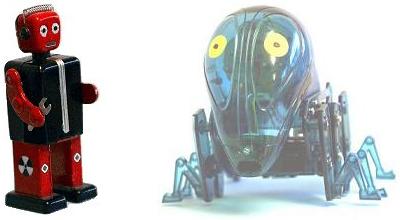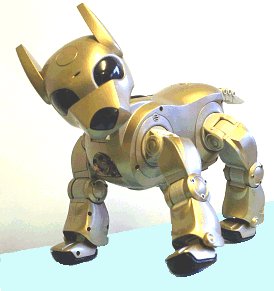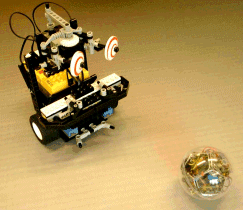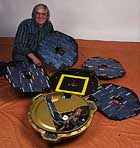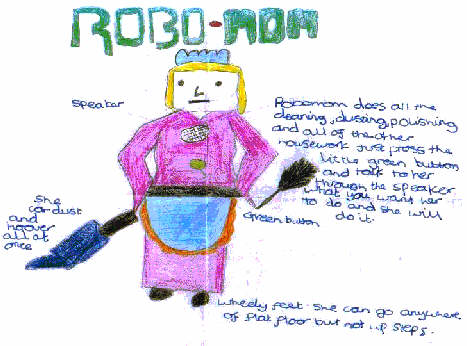  Robotics Minicourse: Basics of RoboticsWelcome to this Open University robotics minicourse, which is aimed at anyone who has a general interest in robots and now wishes to learn more about robotics. We hope you'll find the course entertaining, informative and worthwhile!
The minicourse concludes with some multiple-choice questions. Building robots involves the development of a wide range of skills, including creative thinking, design, mechanics, electronics and programming - all of which are highly valued in industry. Your interest in the subject could lead you into an exciting and fulfilling career at the cutting edge of technology! You can follow up this minicourse by taking the Open University's short course T184 Robotics and the meaning of life: a practical guide to things that think which will further develop your knowledge and practical skills in robotics. There is a version of this course offered by some schools. To find out more about this, see the Open University Young Applicants in Schools Scheme. What are robots?Nowadays, the word robot is often applied to any device that works automatically or by remote control, especially a machine (automaton) that can be programmed to perform tasks normally done by people.
Before the 1960s, robot usually meant a manlike mechanical device (mechanical man or humanoid) capable of performing human tasks or behaving in a human manner. Today robots come in all shapes and sizes, including small robots made of LEGO, and larger wheeled robots that play robot football with a full-size ball. What many robots have in common is that they perform tasks that are too dull, dirty, delicate or dangerous for people. Usually, we also expect them to be autonomous, that is, to work using their own sensors and intelligence, without the constant need for a human to control them. Looked at this way, a radio controlled aeroplane is not a robot, nor are the radio controlled combat robots that appear on television. However, there is no clear dividing line between fully autonomous robots and human-controlled machines. For example, the robots that perform space missions on planets like Mars may get instructions from humans on Earth, but since it can take about ten minutes for messages to get back and forth, the robot has to be autonomous during that time. Where did the word robot originate?The word robot was introduced in 1920 in a play by Karel Capek called R.U.R. , or Rossum's Universal Robots. Robot comes from the Czech word robota, meaning forced labour or drudgery. In the play, human-like mechanical creatures produced in Rossum's factory are docile slaves. Since they are just machines, the robots are badly treated by humans. One day a misguided scientist gives them emotions, and the robots revolt, kill nearly all humans and take over the world. However, because they are unable to reproduce themselves, the robots are doomed to die. However, the sole surviving human creates a male and a female robot to perpetuate their species. Have people always been fascinated by human-like machines?The roots of robotics can be traced back to Greek mythology and Jewish mysticism. Several myths from Ancient Greece tell of statues being brought to life. According to Aristotle, the legendary Greek inventor, Daedalus (whose son Icarus flew too close to the sun), created animated statues that guarded the entrance to the Labyrinth in Crete. The Jewish Talmud describes the making of a golem, a clay model brought to life by the chanting of magical combinations of letters from the Hebrew alphabet. A similar idea can be found in medieval alchemy, in which the philosopher's stone was believed to have a life-giving force. Mary Shelley drew upon such traditions in her 1818 novel Frankenstein. What are the Laws of Robotics?The term robotics was coined in the 1940s by science fiction writer Isaac Asimov. In a series of stories and novels, he imagined a world in which mechanical beings were mankind's devoted helpmates. They were constrained to obey what have become known as Asimov's Laws of Robotics:
Asimov’s book of short stories, I, Robot, investigates the interplay between these laws. In one of the stories, there is a scandal because a candidate for mayor is suspected of being a robot – no-one has ever seen him eat, drink, or sleep.
What was the first practical robot?A prototype industrial robot arm named Unimate (designed by George Devol and Joseph Engelberger) was sold to General Motors in 1959. It plucked hot automobile parts out of a die-casting machine and quenched them in water. The 1960s and 1970s saw a revolution in manufacturing as robots replaced humans for many repetitive jobs. However, these robots were not intelligent by today’s standards. Usually they were programmed by humans training their movements, and they had very little decision-making capabilities. There are still many robots like this in factories today, but the trend is towards more intelligent general-purpose robots that can do more than just paint a panel or screw in a bolt. Are space probes robots?Space probes hurtling through the solar system may not seem like robots, but they fully merit that name by performing programmed tasks over long periods without direct human supervision. Operating in the vacuum of space and withstanding exposure to radiation and extremes of temperature, they explore places not yet accessible to humans.
What can't robots do?It is very difficult to give a robot the ability to perform a wide variety of tasks, move around in cluttered surroundings, recognise objects in the ‘real world’, understand normal speech, and think for itself. These are exciting areas of current research in robotics and artificial intelligence.
Another great problem in robotics is getting them to understand language. This is very important in problem-solving. For example, the four cards below have a letter on one side and a number on the other. If a card has a vowel (a, e, i, o, u) on one side then it has an even number on the other. Which cards do you have to turn over to see if this is true? Think about your answer, then point to a card to turn it over.
Now consider the following cards where the rule is ‘every time I go to Paris I go by plane’. Which cards have to be turned over to test this? Again, think about your answer before turning the card over.
The answer to the first question is that you have to turn over the E to see if it has an even number on the back and you have to turn over the 7 to check that it does not have a vowel on the back. In an experiment, only 12% of people got this second part right (did you?). The answer to the second question is much easier. Of course you have to turn over the Paris card to check that it has the word plane on the back, but now it’s much more obvious that you have to turn over the train card to make sure it does not have Paris on the back. In the experiment mentioned above, 60% of people got the second part right. These problems are logically the same, so the experimenters drew the conclusion that the meaning of the symbols is an important part of problem solving. Since robots have very poor language capabilities, their ability to use this kind of reasoning is very limited. Another of the great problems in robotics is getting them to ‘see’. Although it is easy to put a camera on a robot, it is much more difficult to get the robot to understand what is in an image. Most humans have miraculously good vision. We are able to resolve great ambiguity in scenes. It has proved much more difficult to get robots to understand what is in their universe, and machine vision remains one of the big unsolved problems in robotics research.
There are other problems in robotics that make progress slow. For example, your body is covered with skin, and this contains millions of sensors that allow you to do many fantastically precise things. For example, try typing at a computer with gloves on. The lack of touch feedback will make it very difficult. Also your muscles enable you to have very fine control. Even if you are rather clumsy, you are probably much better at manipulating objects than the average robot. Most people would not let a robot dust their favourite china. Will robots ever be as good as humans?Many futurists believe that robots will eventually and inevitably become more capable than humans, but some experts in artificial intelligence assert that machines will never be able to develop the consciousness and emotions needed for reasoning and creativity. Nonetheless, there are already commercially available robots that can live in our houses and do basic chores for us. Robots are very good at processing certain kinds of information, and they are ideally suited to answering the telephone and being controlled over the Internet. The International RoboCup Federation has set itself the challenge
of having a team of humanoid robot football players beat the
human world champions by 2050. Can you image that? It means
that robots will have to become as nimble and skilful as Beckham.
It will require the invention of many new materials –
for example, a human soccer player could be badly hurt if it
clashed with a robot made of metal. It will also require an
enormous improvement in machine vision. If you play sports such
as football, tennis, or even snooker, next time you play think
about the huge amount of information that comes through your
eyes. What is the future for robots?Robotic pets, lawn mowers and vacuum cleaners are already on the market. Following the success of their Aibo robot dog, Sony have developed a humanoid entertainment robot named QRIO. Honda's Asimo welcomes customers to their showrooms in Japan. Toshiba have built a robot that can play volleyball. Fujitsu's HOAP-2 can perform Japanese Sumo wrestling stances, as well as moves from the Chinese martial art taijiquan. Rapid advances are being made in robotic control systems, artificial intelligence, neural networks, and in the miniaturisation, sophistication and reliability of electronic circuitry, sensors and actuators. These are all contributing to a steady increase in the capabilities of robots. Robots currently under development may become widely used in the food, clothing, nuclear and offshore industries, healthcare, farming, transportation, mining and defence. Will robots take over from humans?This is a popular science fiction theme, and the answer depends on whether robots will ever attain consciousness and emotions. In stories like 2001: A Space Odyssey and Terminator, humans always find a way to outwit intelligent machines that try to take over control. That's fiction, however, and fact is often stranger than fiction! The suggestion that robots will take over because they might become more intelligent than humans overlooks one critical fact: the people who have power in human societies are usually not the most intelligent in the obvious, intellectual way. They have different kinds of ‘human intelligence’, including the ability to understand other people, and to influence their behaviour. The sensible answer to the question as to whether robots will take over is that they probably won’t in the near future. There are many reasons for this. The first is that the robots of today have puny brains compared to humans, and they do not have the ability to organise in the same way as humans. Our societies are very complex and allow us to achieve many very advanced things. It is unlikely that robots could overtake us in the near future. Even so, it is something that we should keep an eye on, since all scientists have a responsibility not to do things that damage society. However, for the most part, robots play a very positive role in our societies, and we can expect them to be used in many ways that make life better for us all. If you would like to, why not try out the quiz associated with this minicourse? Go to quiz now. Alternatively, if this minicourse has taken your interest, why not look at the introductory 10 point credit course, T184 - Robotics and the Meaning of Life? |
